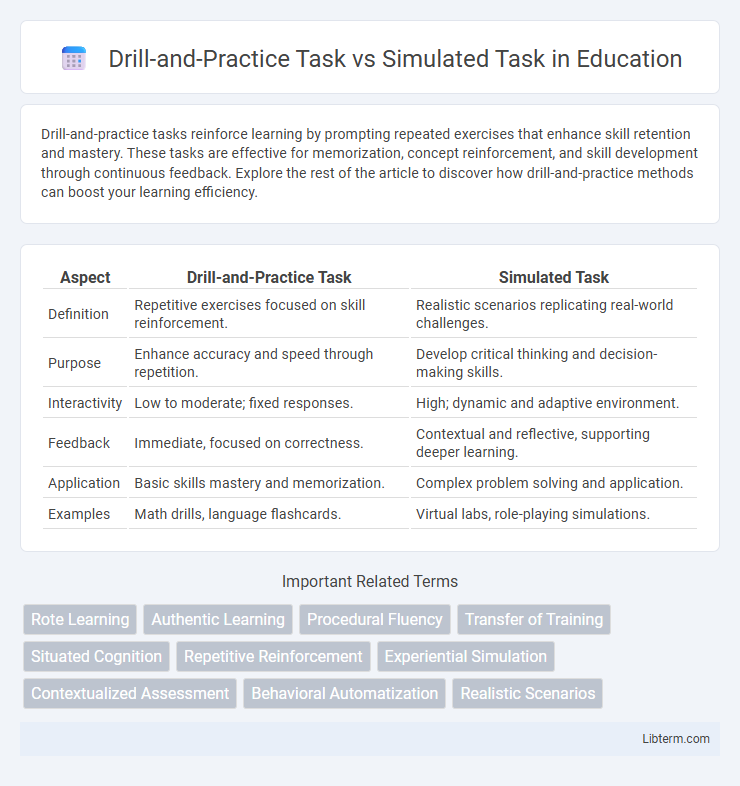Drill-and-practice tasks reinforce learning by prompting repeated exercises that enhance skill retention and mastery. These tasks are effective for memorization, concept reinforcement, and skill development through continuous feedback. Explore the rest of the article to discover how drill-and-practice methods can boost your learning efficiency.
Table of Comparison
| Aspect | Drill-and-Practice Task | Simulated Task |
|---|---|---|
| Definition | Repetitive exercises focused on skill reinforcement. | Realistic scenarios replicating real-world challenges. |
| Purpose | Enhance accuracy and speed through repetition. | Develop critical thinking and decision-making skills. |
| Interactivity | Low to moderate; fixed responses. | High; dynamic and adaptive environment. |
| Feedback | Immediate, focused on correctness. | Contextual and reflective, supporting deeper learning. |
| Application | Basic skills mastery and memorization. | Complex problem solving and application. |
| Examples | Math drills, language flashcards. | Virtual labs, role-playing simulations. |
Introduction to Drill-and-Practice vs Simulated Tasks
Drill-and-practice tasks emphasize repetitive exercises designed to reinforce specific skills or knowledge through consistent practice and immediate feedback. Simulated tasks replicate real-world scenarios, enabling learners to apply their skills in dynamic, context-rich environments that mimic actual challenges. Both approaches serve distinct educational purposes, with drill-and-practice enhancing foundational proficiency and simulations fostering critical thinking and problem-solving abilities.
Defining Drill-and-Practice Tasks
Drill-and-practice tasks involve repetitive exercises designed to reinforce specific skills or knowledge through consistent practice, emphasizing accuracy and speed. These tasks typically focus on memorization, fact recall, and procedural fluency, often utilized in subjects like math and language learning. By repeatedly engaging with the material, learners enhance retention and automaticity, distinguishing drill-and-practice tasks from simulated tasks that mimic real-world scenarios for applied problem-solving.
Understanding Simulated Tasks
Simulated tasks replicate real-world scenarios, providing immersive environments for practical skill development and decision-making under realistic conditions. These tasks enhance cognitive abilities by integrating complex variables and require adaptive problem-solving, unlike drill-and-practice tasks that emphasize repetitive skill reinforcement. Understanding simulated tasks is crucial for training in fields such as aviation, healthcare, and emergency response, where experiential learning significantly improves performance and safety outcomes.
Key Differences Between Drill-and-Practice and Simulated Tasks
Drill-and-practice tasks emphasize repetitive exercises to reinforce specific skills or knowledge, often in structured formats like quizzes or flashcards that target memorization and accuracy. Simulated tasks create immersive, real-world scenarios enabling users to apply skills in dynamic contexts, fostering problem-solving and decision-making abilities under realistic conditions. The key difference lies in the former's focus on repetition for mastery, while the latter prioritizes experiential learning through contextual application.
Advantages of Drill-and-Practice Tasks
Drill-and-practice tasks enhance skill acquisition by reinforcing specific knowledge through repetitive exercises, leading to improved retention and mastery. These tasks provide immediate feedback, enabling learners to identify and correct errors quickly, which accelerates learning efficiency. Their structured format makes them ideal for foundational skills development, especially in subjects like mathematics and language learning.
Advantages of Simulated Tasks
Simulated tasks provide immersive, real-world scenarios that enhance experiential learning and skill transfer more effectively than drill-and-practice tasks. They foster critical thinking, problem-solving, and decision-making by allowing learners to interact dynamically with complex environments. This active engagement promotes deeper understanding and retention compared to repetitive, isolated skill drills.
Limitations and Challenges of Drill-and-Practice Tasks
Drill-and-practice tasks often face limitations such as promoting rote memorization without fostering deep understanding or critical thinking skills, which can hinder long-term knowledge retention. These tasks may also lead to learner disengagement due to their repetitive nature and lack of contextual relevance. Furthermore, drill-and-practice approaches struggle to adapt to individual learner needs, limiting personalized feedback and adaptive learning opportunities essential for skill mastery.
Limitations and Challenges of Simulated Tasks
Simulated tasks often face limitations such as high development costs and the need for sophisticated technology, which can restrict accessibility and scalability. Challenges include ensuring realistic scenarios that accurately mimic real-world contexts, while avoiding overly complex interfaces that may overwhelm learners. Additionally, the effectiveness of simulated tasks depends heavily on the learner's ability to transfer skills to actual situations, which is not always guaranteed.
Choosing the Right Task for Learning Objectives
Selecting the appropriate task between drill-and-practice and simulated tasks depends heavily on specific learning objectives. Drill-and-practice tasks excel in reinforcing foundational skills and memorization through repetitive exercises, ideal for mastering basic concepts and procedures. Simulated tasks, however, engage learners in realistic scenarios that promote critical thinking and problem-solving, making them suitable for applying knowledge in complex, real-world contexts.
Future Trends in Educational Task Design
Future trends in educational task design emphasize the integration of adaptive learning technologies within drill-and-practice tasks to personalize student experiences and improve skill retention through immediate feedback and customization. Simulated tasks are increasingly leveraging immersive technologies like virtual reality (VR) and augmented reality (AR) to create realistic, engaging environments that enhance critical thinking and problem-solving abilities. The convergence of AI-driven analytics and immersive simulations promises to revolutionize formative assessment, enabling real-time performance tracking and tailored instructional interventions.
Drill-and-Practice Task Infographic

 libterm.com
libterm.com